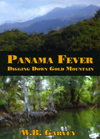Panama Fever
This microscopic look at France’s attempt to join two different parts of the world through outside labor is done in an honest and unbiased way through the two very different characters of Thomas and Byron. W.B. Garvey, the author of this climatic and colorful novel, writes with a straightforward and no-games-played style that evokes as broad a spectrum of emotion as the music Garvey is famous for playing on his violin. In his novel, Panama Fever, Garvey details the beginning stages of what we now know as the Panama Canal, enriching the pages with truthful character and landscape settings.
This microscopic look at France’s attempt to join two different parts of the world through outside labor is done in an honest and unbiased way through the two very different characters of Thomas and Byron. W.B. Garvey, the author of this climatic and colorful novel, writes with a straightforward and no-games-played style that evokes as broad a spectrum of emotion as the music Garvey is famous for playing on his violin. In his novel, Panama Fever, Garvey details the beginning stages of what we now know as the Panama Canal, enriching the pages with truthful character and landscape settings.
The at-turns lush and dry vividness of Central and South America’s wilderness and civilized areas is so skillfully woven into the text that the reader is left with a time warp feeling of accuracy without being bogged down by lengthy and wordy passages of prose. With a sentence, Garvey has the ability to set an intense emotional mood while simultaneously laying a four dimensional portrait of the landscape. The first line of the novel infuses the atmosphere with the same hopeful promise that filled many people at the start of the Panama Canal project: “The Heavens were white and blooming miles above the marsh-strands stretching like fingers inside the lips of Limon Bay.” The lusty desire for success, adventure and a place in history that drove thousands to Panama is rampant within the first few paragraphs of the novel, seduction unveiled.
Floating above the bay, as if by magic, was a city with roofs of spun gold, a tremor of vindication raced down each tense Jamaican spine… With sucked-in breaths the men felt their scalps begin to prickle as beyond the shoreline’s gnarling mangroves loomed a great denseness, vast and impenetrable.
It isn’t long, however, before the characters realize the near impossibility of the massive undertaking and begin to face the personal, natural and man-based obstacles that drive this book right until the last page.
The novel opens with Thomas and Byron as new “friends,” to use the word lightly. Although the men are the same age and both are Jamaicans by birth, “country boy” Byron looks up to Thomas, who was raised with privilege.
Thomas was amused and secretly flattered by the guileless way Byron had attached himself to his side. It gave him added satisfaction to know that even though Byron was eight days his senior and suffered more of life’s hard knocks the little recruit still looked up to him. That Byron wanted so desperately to be his friend when he had every reason to resent him only bolstered his newly-conceived ambition to be the small man’s champion.
Both only seventeen years old at the start, Thomas is as naïve as Byron is innocent. After only a few days together, Thomas saves Byron after an accident, and they are separated. This is the only moment in which Thomas truly acts on behalf of Byron without selfish motivation. Despite the fact that Byron tries unceasingly to contact his friend through correspondence and dangerous voyages while Thomas doesn’t recognize his efforts and is instead absorbed by his own exploits, Garvey manages to portray neither character as “good” or “bad.” While sometimes the reader may get impatient with Thomas’s selfishness and Byron’s lack of self confidence, we are still constantly sympathizing with and rooting for both characters. Even the seemingly cold-hearted, ambitious French recruiter, Henry Duvay leaves room for the reader’s occasional sympathy.
“You don’t understand,” Duvay said sadly, putting down the kaleidoscopic little globe to face his former protégé. “Whether this was a crazy dream or not does not mean we could have abandoned things sooner. Even had we never tried, somewhere men would have died, there would still be a failure. We need this canal. Without it there will never be light across the whole sorry world and the poor that you pretend to care for so deeply will perish in darkness. What we have started is not the end.”
Throughout the novel, Garvey writes about opposition in a matter of fact, almost subtle way without taking sides. Dark versus light skin. Rich versus poor. Father against son. Religious Order versus the common man. French against British against Jamaicans. He doesn’t merely gloss the issues, but he doesn’t overwhelm the novel with dramatic and clichéd anecdotes either. Like he does so well with Thomas and Byron, Garvey paints all groups and individuals empathetically.
Although the end of the novel does not coincide with the completion of the Panama Canal, the knowledge of its eventual success is tempered by the reader’s awareness of the lives that were changed and lost during the long years that led to its current existence. But Garvey’s novel is not just accurate and moving historical fiction. Panama Fever is a humanitarian piece of art, with as many lyrical crests and valleys as a string ensemble, and as equally vivid and dreary as a South American panoramic view of the rainforest.




